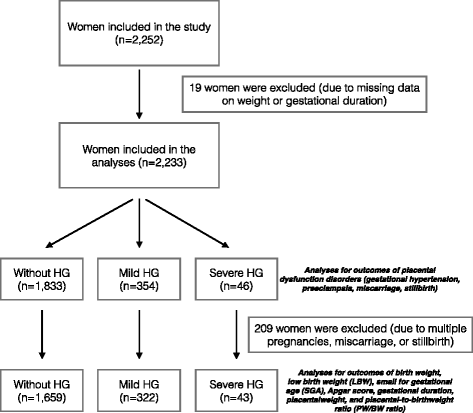Hyperemesis gravidarum and placental dysfunction disorders
- PMID: 27884114
- PMCID: PMC5123279
- DOI: 10.1186/s12884-016-1174-7
Hyperemesis gravidarum and placental dysfunction disorders
Abstract
Background: Evidence about the consequence of hyperemesis gravidarum (HG) on pregnancy outcomes is still inconclusive. In this study, we evaluated if occurrence of hyperemesis gravidarum is associated with placental dysfunction disorders and neonatal outcomes.
Methods: A prospective cohort study was conducted in a maternal and child health primary care referral center, Budi Kemuliaan Hospital and its branch, in Jakarta, Indonesia. 2252 pregnant women visiting the hospital for regular antenatal care visits from July 2012 until October 2014 were included at their first clinic visit. For women without, with mild and with severe hyperemesis, placental dysfunction disorders (gestational hypertension, preeclampsia (PE), stillbirth, miscarriage), neonatal outcomes (birth weight, small for gestational age (SGA), low birth weight (LBW), Apgar score at 5 min, gestational age at delivery) and placental outcomes (placental weight and placental-weight-to-birth-weight ratio (PW/BW ratio)) were studied.
Results: Compared to newborns of women without hyperemesis, newborns of women with severe hyperemesis had a 172 g lower birth weight in adjusted analysis (95%CI -333.26; -10.18; p = 0.04). There were no statistically significant effects on placental dysfunction disorders or other neonatal outcome measures.
Conclusions: The results of our study suggest that hyperemesis gravidarum does not seem to induce placental dysfunction disorders, but does, if severe lead to lower birth weight.
Keywords: Hyperemesis gravidarum; Offspring; Placental dysfunction disorders; Pregnancy.
Similar articles
-
Hyperemesis gravidarum and risks of placental dysfunction disorders: a population-based cohort study.BJOG. 2013 Apr;120(5):541-7. doi: 10.1111/1471-0528.12132. Epub 2013 Jan 30. BJOG. 2013. PMID: 23360164 Free PMC article.
-
Outcomes of pregnancies complicated by hyperemesis gravidarum.Arch Gynecol Obstet. 2012 Jun;285(6):1517-21. doi: 10.1007/s00404-011-2176-3. Epub 2011 Dec 24. Arch Gynecol Obstet. 2012. PMID: 22198830
-
Is hyperemesis gravidarum associated with placental weight and the placental weight-to-birth weight ratio? A population-based Norwegian cohort study.Placenta. 2013 Nov;34(11):990-4. doi: 10.1016/j.placenta.2013.08.001. Epub 2013 Aug 28. Placenta. 2013. PMID: 23993392
-
Placenta-associated adverse pregnancy outcomes in women experiencing mild or severe hyperemesis gravidarum - a systematic review and meta-analysis.BMC Pregnancy Childbirth. 2023 May 24;23(1):375. doi: 10.1186/s12884-023-05691-6. BMC Pregnancy Childbirth. 2023. PMID: 37226133 Free PMC article.
-
Adverse obstetric and neonatal outcomes in women with mental disorders.Thromb Res. 2015 Feb;135 Suppl 1:S60-3. doi: 10.1016/S0049-3848(15)50446-5. Epub 2015 Feb 9. Thromb Res. 2015. PMID: 25903540 Review.
Cited by
-
Comparative Analysis of Maternal and Fetal Outcomes of Pregnancies Complicated and Not Complicated with Hyperemesis Gravidarum Necessitating Hospitalization.Medeni Med J. 2020;35(1):8-14. doi: 10.5222/MMJ.2020.57767. Epub 2020 Feb 28. Medeni Med J. 2020. PMID: 32733744 Free PMC article.
-
Managing hepatic complications of pregnancy: practical strategies for clinicians.BMJ Open Gastroenterol. 2022 Mar;9(1):e000624. doi: 10.1136/bmjgast-2021-000624. BMJ Open Gastroenterol. 2022. PMID: 35292523 Free PMC article. Review.
-
Maternal type 1collagen N-terminal telopeptide levels in severe hyperemesis gravidarum.BMC Pregnancy Childbirth. 2018 Dec 20;18(1):502. doi: 10.1186/s12884-018-2149-7. BMC Pregnancy Childbirth. 2018. PMID: 30572827 Free PMC article.
-
Emerging Progress in Nausea and Vomiting of Pregnancy and Hyperemesis Gravidarum: Challenges and Opportunities.Front Med (Lausanne). 2022 Jan 10;8:809270. doi: 10.3389/fmed.2021.809270. eCollection 2021. Front Med (Lausanne). 2022. PMID: 35083256 Free PMC article. Review.
-
Does body mass index early in pregnancy influence the risk of maternal anaemia? An observational study in Indonesian and Ghanaian women.BMC Public Health. 2018 Jul 13;18(1):873. doi: 10.1186/s12889-018-5704-2. BMC Public Health. 2018. PMID: 30005609 Free PMC article.
References
-
- Einarson TR, Piwko C, Koren G. Quantifying the global rates of nausea and vomiting of pregnancy: a meta-analysis. J Popul Ther Clin Pharmacol. 2013;20(2):e171–83. - PubMed
-
- Vikanes A, Grjibovski AM, Vangen S, Magnus P. Variations in prevalence of hyperemesis gravidarum by country of birth: a study of 900,074 pregnancies in Norway, 1967–2005. Scand J Public Health. 2008;36(2):135–42. doi: 10.1177/1403494807085189. - PubMed
-
- Jordan V, MacDonald J, Crichton S, Stone P, Ford H. The incidence of hyperemesis gravidarum is increased among Pacific Islanders living in Wellington. N Z Med J. 1995;108(1006):342–344. - PubMed
-
- Matsuo K, Ushioda N, Nagamatsu M, Kimura T. Hyperemesis gravidarum in Eastern Asian population. Gynecol Obstet Invest. 2007;64(4):213–6. doi: 10.1159/000106493. - PubMed
MeSH terms
LinkOut - more resources
Full Text Sources
Other Literature Sources


